
Emergency medical services (EMS), also known as ambulance services or paramedic services, are emergency services that provide urgent pre-hospital treatment and stabilisation for serious illness and injuries and transport to definitive care. They may also be known as a first aid squad, FAST squad, emergency squad, ambulance squad, ambulance corps, life squad or by other initialisms such as EMAS or EMARS.
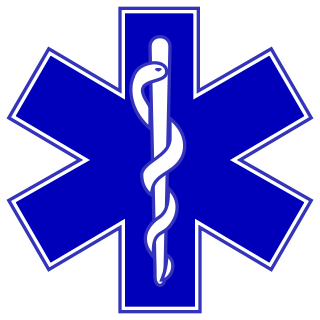
An emergency medical technician is a medical professional that provides emergency medical services. EMTs are most commonly found serving on ambulances.

A paramedic is a healthcare professional who responds to emergency calls for medical help outside of a hospital. Paramedics mainly work as part of the emergency medical services (EMS), most often in ambulances. The scope of practice of a paramedic varies among countries, but generally includes autonomous decision making around the emergency care of patients.

The National Association of Government Employees (NAGE) is a registered labor union with the United States Department of Labor representing approximately 43,000 members in the United States of America. NAGE represents a variety of workers including state and federal government employees, municipal employees, registered nurses, EMS professionals including EMTs and paramedics, firefighters, law enforcement professionals including police and correctional officers and military air technicians. NAGE is an affiliate of the Service Employees International Union (SEIU).

In the United States, the paramedic is a allied health professional whose primary focus is to provide advanced emergency medical care for patients who access Emergency Medical Services (EMS). This individual possesses the complex knowledge and skills necessary to provide patient care and transportation. Paramedics function as part of a comprehensive EMS response under physician medical direction. Paramedics often serve in a prehospital role, responding to Public safety answering point (9-1-1) calls in an ambulance. The paramedic serves as the initial entry point into the health care system. A standard requirement for state licensure involves successful completion of a nationally accredited Paramedic program at the certificate or associate degree level.
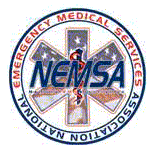
The National Emergency Medical Services Association (NEMSA or National EMS Association) is a now defunct, registered labor union and California non-profit mutual benefit corporation. NEMSA's membership consists of emergency medical technicians (EMTs), and paramedics.

Louisville Metro Emergency Medical Services is the primary provider of pre-hospital life support and emergency care within Louisville-Jefferson County, Kentucky. LMEMS is a governmental department that averages 90,000 calls for service, both emergency and non-emergency, each year.
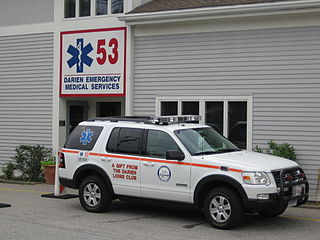
In the United States, emergency medical services (EMS) provide out-of-hospital acute medical care and/or transport to definitive care for those in need. They are regulated at the most basic level by the National Highway Traffic Safety Administration, which sets the minimum standards that all states' EMS providers must meet, and regulated more strictly by individual state governments, which often require higher standards from the services they oversee.
Boston Emergency Medical Services provides basic life support (BLS) and advanced life support (ALS) ambulance units throughout the neighborhoods in the city of Boston, Massachusetts, USA. Boston EMS is a public safety agency responding to 911 calls alone or with the Boston Police and/or Boston Fire Departments dependent upon the nature of an incident. The agency employs over 400 emergency medical technicians (EMT) and paramedics.
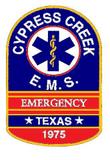
Cypress Creek Emergency Medical ServicesAssociation, also known as Cypress Creek EMS (CCEMS) was a private, non-profit emergency medical service provider for Harris County ESD 11 in North Harris County, within greater Houston, Texas. In 2021, CCEMS declared bankruptcy and operations ceased in mid 2022. In late 2022, the remaining assets, branding, and trademarks were bought by Viking Enterprises, DBA City Ambulance Service. All ambulances in use by CCEMS are Mobile Intensive Care Units (MICU), with at least one Paramedic, making all ambulances ALS units. Cypress Creek EMS provided 911 service in North Harris County, provided bicycle medic teams for special events, provided tactical EMS support for federal, state, and local law enforcement, and operated an accredited educational institution.
An advanced emergency medical technician is a provider of emergency medical services in the United States. A transition to this level of training from the emergency medical technician-intermediate, which have somewhat less training, began in 2013 and has been implemented by most states. AEMTs are not intended to deliver definitive medical care in most cases, but rather to augment prehospital critical care and provide rapid on-scene treatment. AEMTs are usually employed in ambulance services, working in conjunction with EMTs and paramedics; however they are also commonly found in fire departments and law enforcement agencies as non-transporting first responders. Ambulances operating at the AEMT level of care are commonplace in rural areas, and occasionally found in larger cities as part of a tiered-response system, but are overall much less common than EMT- and paramedic-level ambulances. The AEMT provides a low-cost, high-benefit option to provide advanced-level care when the paramedic level of care is not feasible. The AEMT is authorized to provide limited advanced life support, which is beyond the scope of an EMT.
The Gila River Indian Community Emergency Medical Services provides paramedic, ambulance and rescue services for the Gila River Indian Community. A subsidiary of the tribally owned Gila River Healthcare hospital, Gila River EMS is considered a third service model and provides emergency medical and rescue services to the Gila River Indian Community in conjunction with the Gila River Police Department and the Gila River Fire Department. Gila River EMS headquarters are located in Sacaton, Arizona.
The Union Volunteer Emergency Squad provides emergency services for the Town of Union, New York, USA.
Statcom - Citywide MARTA Mission Critical EMS Rescue / Fire Rescue & SecureMobility Transit is the largest private provider of advanced life support (ALS) and basic life support (BLS) ambulance transportation services in the tri-state area. Its main operation areas of New York City, the Hudson Valley, Long Island, the state of Delaware, the Baltimore-Washington DC corridor and in numerous locations in Pennsylvania. It was the largest privately owned ambulance service in the Mid-Atlantic. It was the largest privately owned public benefits corporation ambulance and paratransit service in the Tri-State Area

Alamo Emergency Medical Services, Inc. was an Advanced Life Support (ALS) and Basic Life Support (BLS) ambulance service owned by Health Quest, with transportation services in the Hudson Valley region of New York. Alamo operated ambulances staffed by emergency medical technicians (EMTs) and paramedics.
Cataldo Ambulance Service and Atlantic Ambulance Service are a private emergency medical services (EMS) provider in the Greater Boston and North Shore areas of the Commonwealth of Massachusetts, licensed at the advanced life support (ALS) level by the Massachusetts Department of Public Health. As of October 2022, Cataldo had 48 ambulances registered with the state, while the Atlantic division had an additional 45. Headquartered in Somerville, Massachusetts, and with base locations throughout the North Shore, Cataldo provides 911 and interfacility transportation (IFT) ambulance service to several communities, hospitals, and nursing facilities in Massachusetts. Cataldo also operates SmartCare, a mobile integrated health (MIH) provider.
The New York City Fire Department Bureau of Emergency Medical Services is a division of the New York City Fire Department (FDNY) in charge of emergency medical services for New York City. It was established on March 17, 1996, following the merger of the FDNY and New York City Health and Hospitals Corporation's emergency medical services division. FDNY EMS provides coverage of all five boroughs of New York City with ambulances and a variety of specialized response vehicles.

IAEP is a labor union, a division of NAGE / SEIU Local 5000 that represents EMS professionals working for public, "third service", and private ambulance in self-autonomous union locals. IAEP locals elect their own local governing executive boards and officers and are provided representational, legal, contract, and political support by NAGE but govern and manage their own affairs.

The Recognition of EMS Personnel Licensure Interstate CompAct, also known as REPLICA, is an interstate compact that extends a "privilege to practice" in the United States from a 'home state' to 'remote states' for qualified Emergency Medical Services personnel. For a state to participate in the compact, a state must pass the model legislation into law. On October 11, 2017, when Georgia signed the REPLICA legislation into law, the EMS Compact was formalized and the Interstate Commission for EMS Personnel Practice was established.
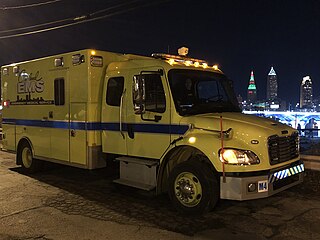
The City of Cleveland Division of Emergency Medical Service, also known as Cleveland EMS or CEMS, is the division of the municipal government tasked with emergency ambulance transport for the City of Cleveland, Ohio.












